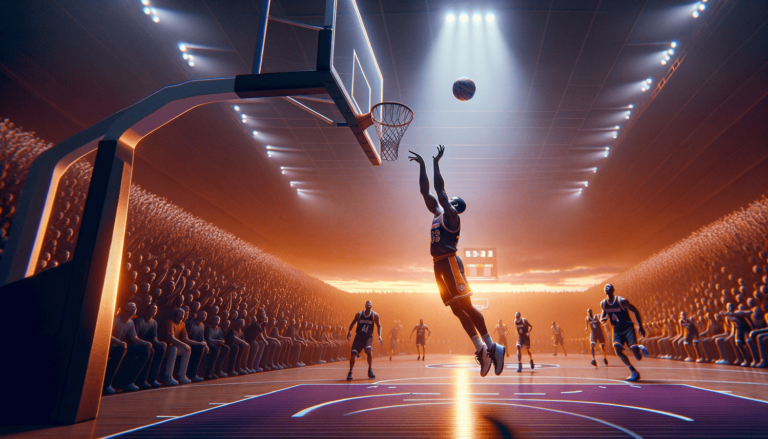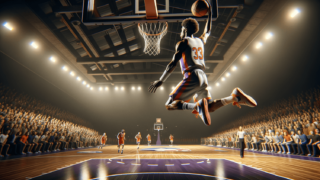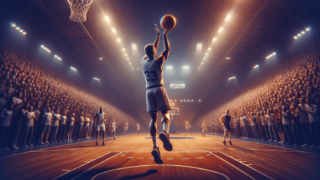
Basketball’s Half-Court Shot Rule: When It Counts
Written by: Basketball Universe
Last updated:

Half-court heaves, those pulse-pounding, Hail Mary shots that are rarely seen but always thrilling to witness – this game changer is a thing of legend. In this blog post, we’ll dive deep into Basketball’s Half-Court Shot Rule: When It Counts, taking you through the mechanics, the strategies, and the sheer excitement that surrounds this formidable shot. So whether you’re a casual fan, a basketball enthusiast, or a player eager to expand your knowledge, join us on this thrilling journey to explore the gravity-defying wonder of the half-court shot, and unveil the secrets of when this extraordinary feat becomes a game-winning reality.
Basketball’s Half-Court Shot Rule: When It Counts
In basketball, a half-court shot counts when a player releases the ball prior to the expiration of the game or shot clock, successfully launching it into the opponent’s basket from beyond the half-court line. Given their rarity and difficulty, half-court shots are typically attempted during buzzer-beater situations as a final scoring effort before the clock runs out. When successful, this incredible feat awards the player’s team three points, eliciting excitement from fans and teammates alike.
Unlocking the Intricacies of the Half-Court Shot Rule
Diving into the captivating world of half-court shots, it’s important to grasp the rules governing this high-stakes game element. Reinforcing our understanding of the game’s mechanics will help us uncover the secrets behind these thrilling shots. From buzzer-beaters to tiebreakers, let’s explore the fascinating nuances of basketball rules.
Official Rulebooks and Recognized Half-Court Shots
One of the critical components of determining when a half-court shot counts relies on the official rulebook used at a particular game level. Within the basketball community, there are several major rulebooks, including FIBA, NBA, NCAA, and NFHS. Each rulebook contains guidelines on how to handle various game situations, including the specific position of the half-court line and crucial timing aspects.
Fundamental Rules and Timing Essentials
In all basketball rulebooks, a valid half-court shot must comply with specific rules and regulations. Notably, the player attempting the shot must release the ball before the game or shot clock expires. Additionally, the shot must be launched from behind the half-court line, and any contact between the player and the line results in a violation.
Differentiating Between Half-Court and Full-Court
Understanding the distinction between half-court and full-court will shed light on the unique challenges involved in executing a successful half-court shot. While full-court play features two teams competing over the entire court, half-court games often involve smaller teams and center around just one basket. The latter restricts the number of players who can attempt half-court shots, adding to their rarity and excitement.
Perfecting the Art of Half-Court Shooting
As an aspiring half-court shot expert, it’s essential to polish your skills through practice and strategy development. Let’s dive into various aspects that contribute to mastering the half-court shot, from proper techniques to improvised adaptations.
The Techniques Behind a Successful Half-Court Shot
Executing an impeccable half-court shot involves a combination of skill, timing, and technique. A solid understanding of shooting fundamentals is crucial. Here are some steps to practice:
- A firm stance with balanced feet.
- Bending the knees and positioning the hips correctly.
- Aligning your shooting arm and hand with the target.
- Releasing the ball with a smooth and fluid motion.
- Following through with your wrist and fingers.
While the fundamentals remain the same, the primary difference in a half-court shot is the increased focus on power and momentum to cover the greater distance to the basket. Half-court shots are physically demanding, requiring strength and accuracy in equal measures.
Adapting Your Shot: Tips for Success
Half-court shots are unique situations that demand players adapt their techniques and strategies. Here are a few tips to enhance your chances for success:
- Build your leg strength to generate power for longer shots.
- Master the one-handed push, an alternative shooting technique.
- Ensure your follow-through is precise to maintain accuracy.
- Practice high-arcing shots for an optimal trajectory.
- Emphasize shot rotation to add stability to your attempts.
Buzzer-Beating Half-Court Shots: Making the Impossible, Possible
Buzzer-beating, game-winning half-court shots are the stuff of basketball legend. With the game hanging in the balance, a successful shot can instantly catapult a player into the annals of hoops history. In this high-pressure environment, grit and determination are the keys to overcoming the odds and turning the tables in your favor.
The Role of the Clock
As previously mentioned, a crucial aspect of half-court shots counting is the timing. Players must release the ball before the game or shot clock expires, and the looming deadline can significantly impact accuracy and performance. This added pressure only amplifies the importance of honing shooting skills and mental toughness to ensure a successful outcome.
Mastering the Mental Game
A strong mental game is a crucial component of thriving under pressure. Harnessing nerves and maintaining focus in buzzer-beater situations can often be the difference between sinking a game-winning shot or falling just short. Here are some tips on developing mental resilience:
- Maintain a calm and confident mindset.
- Visualize successful shots before attempting them.
- Practice mindfulness techniques to stay in the present moment.
- Draw strength from past successes and positive experiences.
- Embrace the challenge and enjoy the thrill of competition.
Half-Court Shot Contests: A Chance to Win Big
Half-court shot contests hosted during timeouts or halftime events have become a popular fixture at many basketball games. With fans given the opportunity to win cash prizes, cars, and more, these events add an extra layer of excitement to the game experience. Let’s take a closer look at the unique dynamics of half-court shot contests and how to maximize your chances of success.
Understand the Contest Rules
It’s essential to familiarize yourself with the specific rules of each contest, as they may vary. Some contests have special regulations, such as launching the shot within a certain timeframe or specific requirements on shooting technique. Ensure you’re comfortable with the rules before taking the court to increase your chances of winning.
Prepare for the Contest Atmosphere
While the mechanics of shooting remain consistent, the contest atmosphere presents its own set of challenges. With thousands of onlookers and amplified pressure, it’s essential to remain composed and focused on your shot. Practice under pressure and simulate the contest environment as closely as possible to prepare.
In Conclusion: Embrace the Magic of Half-Court Shots
Half-court shots are a legendary aspect of basketball that captures the hearts and minds of players, fans, and the wider sports community. As we delve into the intricacies of half-court shot rules, techniques, and mental aspects, we can continue to marvel at the wonder and excitement this extraordinary feat generates. Armed with newfound knowledge and appreciation, let’s revel in the magical moments of half-court shots that unite us all in our love for the great game of basketball.
I hope you find this article helpful and informative. Embrace the excitement of basketball and the legendary half-court shot. Never stop learning and always strive to improve your game. Remember, practice makes perfect, and the joy of the game is yours to experience!
Remarkable Half-Court Shots in Basketball History
Half-court shots leave an indelible mark on the collective imagination of basketball fans. These unforgettable moments exemplify the power of skill, technique, and determination on the court. Let’s pay homage to some of the most amazing half-court shots in basketball history, highlighting their impact on both the game and its audience.
1. Jerry West’s 60-Foot Shot (1970 NBA Finals)
Los Angeles Lakers legend Jerry West stunned basketball fans during Game 3 of the 1970 NBA Finals against the New York Knicks, sinking a 60-foot shot to tie the game and send it to overtime. Although the Lakers ultimately lost, West’s shot remains one of the most electrifying moments in NBA history.
2. Baron Davis’ Off-Balance Buzzer-Beater (2001 Regular Season)
Golden State Warriors’ Baron Davis demonstrated his incredible skill with a breathtaking off-balance buzzer-beater against the Dallas Mavericks. Despite heavy defensive pressure, Davis successfully launched a half-court shot, leaving fans in awe and adding to his team’s victory.
3. LeBron James’ Stunning Fadeaway (2010 Regular Season)
LeBron James, then playing for the Cleveland Cavaliers, achieved a stunning fadeaway half-court shot against the Milwaukee Bucks. Displaying his shooting prowess and ability to perform under pressure, James solidified his status as one of the NBA’s all-time greats.
Conditioning for Half-Court Shot Success
Achieving a successful half-court shot requires more than just technical expertise; maintaining physical fitness and optimal conditioning is also essential. The following key exercises and conditioning techniques can help boost your shot strength, stability, and accuracy.
Strength Training
Incorporating strength training into your exercise routine can significantly improve your ability to execute powerful half-court shots. Squats, lunges, and deadlifts target the essential leg muscles needed for generating increased shot force. Additionally, exercises targeting core and upper body strength, such as planks, push-ups, and pull-ups, can contribute to improved stability and accuracy.
Flexibility and Mobility
Becoming more flexible and mobile can enhance your overall shooting ability, ensuring proper form and technique while minimizing the risk of injury. Incorporate stretching and yoga into your conditioning program to improve joint mobility and muscle flexibility, leading to smoother shooting motion and increased shot range.
Plyometrics
Plyometric exercises help develop explosive power and muscle control, which are paramount for executing strong half-court shots. Include exercises like box jumps, broad jumps, and plyometric push-ups in your workout to develop the quick, forceful movements needed for successful long-range shooting.
Embracing the Unpredictable
One of the most captivating elements of basketball is the unpredictable nature of the game. Half-court shots exemplify this excitement, as they provide nail-biting, game-changing moments that inspire awe and admiration. As we continue to learn and appreciate the complexities of half-court shots, let’s celebrate the magic, the skill, and the spirit of the beautiful game of basketball.
FAQ: Half-Court Shots and More
Intrigued by half-court shots and their impact on the game? We’ve compiled a list of frequently asked questions to address common inquiries and provide greater insight into this thrilling aspect of basketball. Discover essential information and deepen your understanding of the strategies, techniques, and rules surrounding half-court shots.
1. What is the proper technique for a half-court shot?
A successful half-court shot involves a combination of shooting fundamentals such as a balanced stance, bending your knees, positioning your hips, pointing your shooting arm and hand towards the target, releasing with a fluid motion, and following through. Additionally, half-court shots require increased power, particularly from the legs and core, to successfully cover the distance to the basket.
2. Is a half-court shot always worth three points?
Yes, a successful half-court shot is always awarded three points since it originates from beyond the three-point arc. However, it’s essential to comply with timing and positioning rules, specifically releasing the ball before the game or shot clock expires and ensuring the shot is taken from beyond the half-court line.
3. Can a player’s foot touch the half-court line when shooting?
No, a player attempting a half-court shot must ensure that their feet do not touch the half-court line. If contact is made with the line during the shot attempt, it will result in a violation, and the shot, if made, will not be counted.
4. What’s the difference between half-court and full-court play?
Full-court play involves two teams competing over the entire court, using both baskets for scoring. In contrast, half-court play typically features smaller teams and centers around one basket, with the half-court line serving as an out-of-bounds marker. Half-court matches limit the number of players who can attempt half-court shots, making them rarer and more exciting.
5. How does a half-court shot count in a buzzer-beater situation?
In a buzzer-beater situation, a half-court shot counts if the player releases the ball before the game or shot clock expires and the ball successfully enters the opponent’s basket. This high-pressure scenario often results in high-intensity and dramatic game finishes, showcasing the players’ abilities to perform under pressure.
6. Are there different rules for half-court shots in different leagues?
While the fundamental rules governing half-court shots remain consistent across various leagues and rulebooks, some minor differences may apply. However, these differences primarily pertain to court dimensions and shot clock durations, while the basic requirements for a valid half-court shot are generally upheld across all leagues.
7. What factors contribute to consistent half-court shot accuracy?
Consistent half-court shot accuracy can be achieved through technical proficiency, strength, flexibility, mobility, and mental focus. Developing a sound shooting technique, engaging in strength training, incorporating flexibility exercises, honing plyometric abilities, and maintaining mental resilience are all essential components of improving half-court shot consistency.
8. How can I improve my chances of winning a half-court shot contest?
To improve your chances of winning a half-court shot contest, familiarize yourself with the specific contest rules, practice shooting under pressure, and simulate the contest environment as closely as possible. Consistent practice and mental preparation can significantly enhance your performance in high-pressure contest situations.
9. What is the role of the shot clock in half-court shots?
The shot clock plays a crucial role in regulating the game’s pace, applying pressure on players to attempt shots within a specified time. In the context of half-court shots, an accurate attempt will only count if the player releases the ball before the shot clock expires.
10. How can I improve my mental game for making half-court shots?
Developing a strong mental game can be achieved through maintaining a calm and confident mindset, visualizing successful shots, practicing mindfulness techniques, drawing strength from past successes, and embracing the challenge of competition. These strategies can help enhance your mental resilience, improving your performance in high-pressure shooting situations.
Featured Posts
- No pillar pages found.





